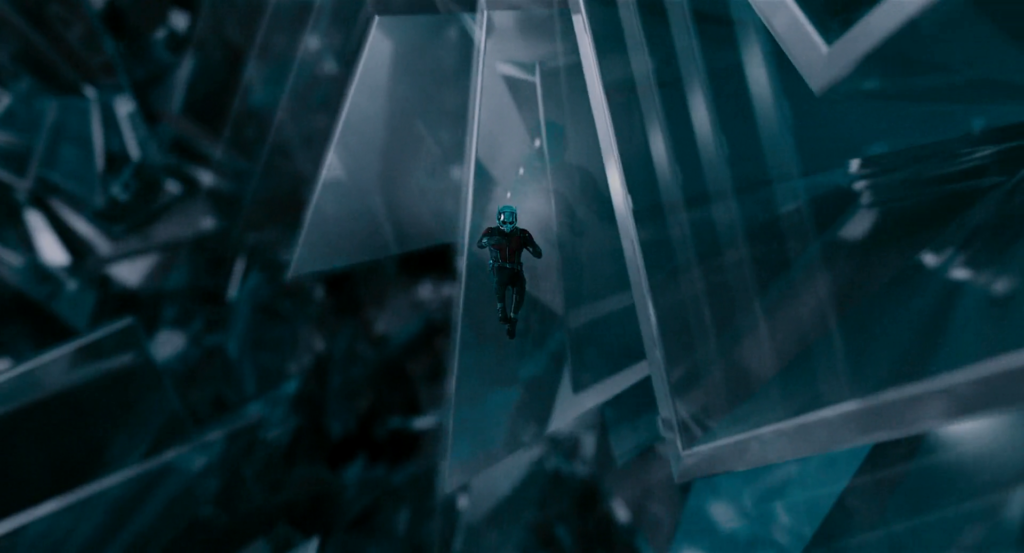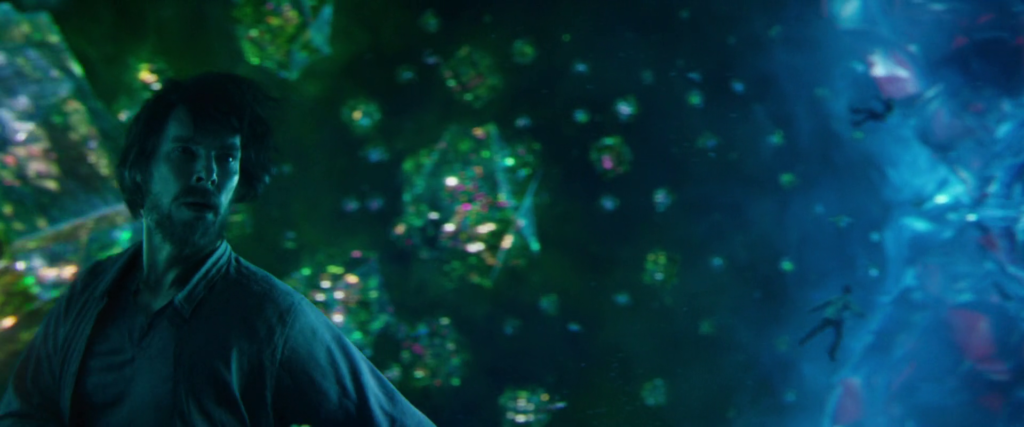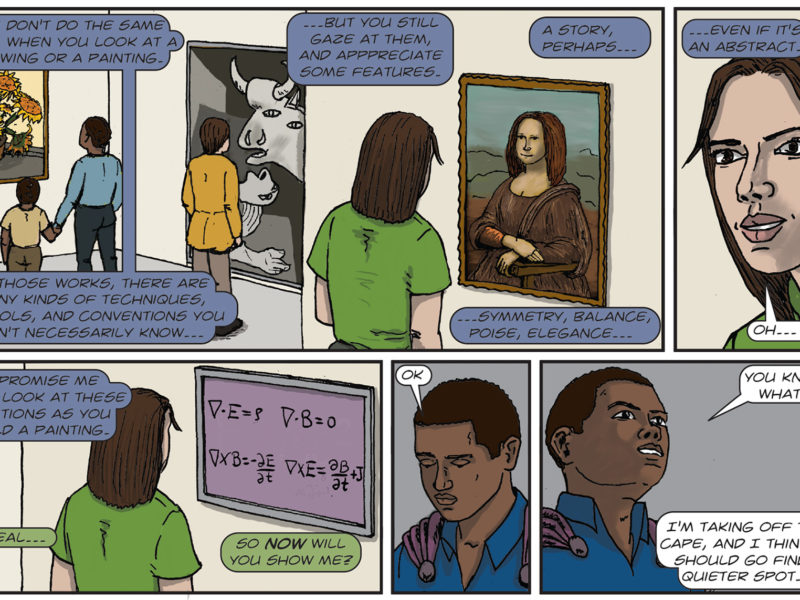In a scene from Spider-Man: Far from Home, first seen on Ellen, Peter Parker/Spider-Man (Tom Holland) meets Quentin Beck/Mysterio (Jake Gyllenhaal) and discovers the new superhero is not from his universe but from a parallel Earth. Beck explains, “There are multiple realities, Peter. This is Earth, dimension 616. I am from Earth-833. We share identical physical constants, Level 4 symmetry.”
Nick Fury (Samuel L. Jackson) explains that Thanos’ snap tore a hole in their dimension, which allowed Mysterio to enter their universe. Peter is naturally excited by this revelation and its implications for cosmology. Who wouldn’t be? What exactly does Mysterio mean by a "Level 4 multiverse"? Is there real-world physics behind that statement and can we figure what this means for the future of Phase 4 and the MCU multiverse?
There are multiple realities, Peter. This is Earth, dimension 616. I am from Earth-833. We share identical physical constants, Level 4 symmetry.
Quentin Beck aka Mysterio in 'Spider-Man: Far from Home'
Setting up the MCU Multiverse
Spider-Man: Far from Home isn’t the first time the MCU has introduced the concept of multiple worlds beyond ours. In Doctor Strange (2016), the Ancient One (Tilda Swinton) tells Stephen Strange (Benedict Cumberbatch) that, “This universe is one of an infinite number. Worlds without end. Some benevolent and life-giving. Others filled with malice and hunger. Dark places, where powers older than time lie... ravenous... and waiting.” Agamotto, the first Sorcerer Supreme to detect other dimensions, dedicates his life to protecting the Earth-realm from extra-dimensional threats. In the Ant-Man movies, both Janet van Dyne (Michelle Pfeiffer), and Scott Lang (Paul Rudd) travel to the Quantum Realm, a dimension where time and space appear to be irrelevant. The multiverse was also a central part in Spider-Man: Into the Spider-verse movie.
This universe is one of an infinite number. Worlds without end. Some benevolent and life-giving. Others filled with malice and hunger. Dark places, where powers older than time lie... ravenous... and waiting.
The Ancient One

New dimensions are nothing new to the MCU. The difference with Mysterio’s big reveal is there are parallel Earths just like ours. So how exactly does everything fit, and is there any truth to what Mysterio says? To answer the question of what the multiverse is, Science vs. Hollywood contacted Roberto Trotta, a theoretical cosmologist from Imperial College who utilizes big data sets from various sources to study dark matter, dark energy, and its relationship to the Big Bang.
Why the need for a Multiverse?
Parallel universes are a popular feature in science fiction but they are far from a mere storytelling device. Physicists are also interested in multiverses as they may answer some of the field's most vexing questions on the universe’s origins. Dr. Trotta explains the reason for a multiverse is because our universe seems rather improbable. The laws of physics are determined by its physical constants; some of these constants tell us what the speed of light is, or the strength of gravity. As we look at how physics works at the fundamental level, we discover that the physical constants seem to be well-chosen and aligned for sentient life to exist.
However, the values of the physical constants are just numbers; there is no reason why they should be the values they are and not be something else. For the universe to arise by chance with those exact values and not driven by some other cause, we need to posit there are many other universes with different physical constants and different laws of physics. Some of these combinations might not allow for sentient life, while others may give rise to different forms of life.
In the Ellen clip, Beck tells Peter they live in a “level 4” multiverse and both universes share the same physical constants. The various levels Beck speaks of, comes from a classification scheme devised by cosmologist Max Tegmark, in his book Our Mathematical Universe. Tegmark posits four different levels or types of universes and their structures, and this describes all the possible combinations of multiverses we can imagine or exists mathematically.
Level 1: Extension of our Universe
The first type is an extension of the universe we live in. In this scenario, the multiverse is infinitely large and divided into different pockets or Hubble volumes that are far apart from each other. Each Hubble volume contains a universe. In this multiverse, the infinite number of Hubble volumes all have the same physical laws and physical constants.

However, because there is an infinite number of Hubble volumes, there will be numerous universes with similar or even identical configurations and histories. Dr. Trotta explains in one universe, there is another you whose life and history is identical to yours in every way. In another universe, there might be a slight change where, instead of wearing a white shirt, your counterpart chose to wear a red shirt today. In another set of universes, your life is completely different and maybe unrecognizable.
Earths-616 and 833 could both fall in this category; each Earth in this multiverse has the same physics and resides in its own Hubble volume. Some Earths will have identical histories but some have completely different timelines. In the case of Earth-833, according to Beck, Spider-Man and the Avengers do not exist; different initial conditions during the Big Bang may have lead to each dimension's unique histories.
Level 2: Universes with different physics
In Spider-Man: Far from Home, Peter considers the implications for the initial singularity. The universe is believed to have expanded from a very high-density and high-temperature state. Cosmologists believe if we were to take the universe today and run its clock backward, just before the high-density and high-temperature state, there was a singularity that started the Big Bang.
In this scenario, the entirety of space will continue stretching forever but some regions will stop expanding to form distinct bubbles. These bubbles are embryonic level 1 multiverses that grow out of a universe. Some bubbles may experience different spontaneous symmetry breaking, which results in different physical constants and laws of physics.

The numerical designations used in the Marvel comics and the MCU does not only identify which Earth we are referring to, but also the other dimensions attached to it. The Dark Dimension of the MCU, seen in Doctor Strange, is a different to the one in the Marvel Comics even though they are both the home of Dormammu. In a sense, each number tells how individual universes across various level 1 multiverses are connected to each other.
At San Diego Comic-Con 2019, Marvel Studios revealed their plans for Phase 4 and the title of the Doctor Strange sequel—Multiverse of Madness. This could be the MCU's first horror movie and could explore some of the darker corners of the MCU multiverse, especially the dimensions filled with malice and hunger that the Ancient One spoke of. Dr. Strange could encounter dimensions where physics is a horrifying reality.
Level 3: What if and Many-Worlds
Many Worlds is one of several interpretations of quantum mechanics. In this version, all possible alternate histories and futures are real, each representing an actual world or universe. This means that reality isn't a single unfolding timeline but a branched tree where the universe splits to create new realities that represent every decision, and possible outcome.
This may sound exactly like level 1 but the difference is where your double lives. As Tegmark explains, "The only difference between Level I and Level III is where your doppelgängers reside. In Level I they live elsewhere in good old three-dimensional space. In Level III they live on another quantum branch in infinite-dimensional Hilbert space."
The only difference between Level I and Level III is where your doppelgängers reside. In Level I they live elsewhere in good old three-dimensional space. In Level III they live on another quantum branch in infinite-dimensional Hilbert space.
Max Tegmark
Fans of Jake Gyllenhaal may already be familiar with the concept from the 2011 film, Source Code. Gyllenhaal plays a time-traveler who relives the last eight minutes preceding a terrorist attack on a Chicago train. Stevens' mission is to find who the terrorist is so he can prevent an attack in the future. Every time he fails and is sent back, he creates a new branch (and reality) in the timeline.
This branching timeline concept is the basis of the What If…? comic series first published in 1977. The series speculates what would have happened if key moments in the Marvel Universe unfolded differently. Some What If stories have been given official numerical designations, officially making them part of the Marvel Comics Multiverse.
Marvel Studios announced the What If...? animated series at San Diego Comic Con 2019, which will introduce Uatu the Watcher (Jeffrey Wright), a member of a cosmic race tasked with watching the events of the Marvel Universe unfold. The Watchers were first seen during a Stan Lee cameo in Guardians of the Galaxy Vol. 2.
In Avengers: Endgame, the Ancient One explains that the Infinity Stones are responsible for the "flow of time." Remove one stone and that flow splits, leaving a new branched reality that is defenseless against the forces of darkness. There aren't any Infinity Stones in the present MCU now that they have now been returned to their proper timelines. What that means could be explored in the future.

Marvel Studios also announced the series Loki, which follows the adventures of the alternate Loki (Tom Hiddleston) who escaped captivity in Avengers: Endgame with the Tesseract during the Time Heist. As this is an alternate timeline, likely to be given its own numerical designation, it is separate from the main MCU timeline.
Level 4: Ultimate Ensemble
The ultimate mathematical universe is a hypothesis proposed by Max Tegmark. In this description, Tegmark argues that our physical reality is not just described by mathematics, it is mathematics. Mathematical existence is the same as physical existence and all structures that exist mathematically exist physically as well.
This may be one of the more confusing aspects of the multiverse. If mathematics define existence and reality then why the need for a fourth level. We can argue that levels 1, 2, and 3 are either connected or equivalent depending on how you look at them. What Tegmark argues is there could be mathematical structures (and physical realities) that we don't know of or are unable to describe. Ultimate ensemble encompasses those physical realities. It means in this categorization, there is nothing beyond the fourth level.
Theoretical Physics in Science Fiction
The MCU has always incorporated scientific elements into their storylines. When asked what he thinks of this as a theoretical physicist, Dr. Trotta said, "It's a wonderful playground both for theoretical physics and science fiction. I very much like the notion that science fiction writers, movie producers, and authors seize on ideas—even though they may be speculative—that are at the edge of theoretical physics and cosmology, and creatively use them as plot devices. They may not be used as intended in physics but that does not matter as long as there is some internal consistency to the story. Good plot devices that are creative and entertaining makes for a wonderful crossover of fields."
Good plot devices that are creative and entertaining makes for a wonderful crossover of fields.
Roberto Trotta
Truth in Mysterio's Web of Lies
Mysterio is one of Spider-Man's most dangerous villains. When Mysterio first appeared in the trailer, comic fans were quick to point out that Beck is a master of illusion and subterfuge was his specialty. The comic book character makes his first appearance in Amazing Spider-Man #13 where he pretends to be a hero who can take down Spider-Man. This was eventually retconned in Spectacular Spider-Man #51 where it was revealed that Beck was in disguise and working with the Tinkerer in Amazing Spider-Man #2.
We see similar retcons in Far from Home. It is revealed that Beck designed Tony Stark's (Robert Downey Jr.) Binarily Augmented Retro-Framing, or B.A.R.F. system seen in Captain America: Civil War (2016). We also the reappearance of William Ginter Riva (Peter Billingsley), the drone creator who first appears in Iron Man (2008). In fact, even the name Quentin Beck is a fabrication. The story of an extradimensional hero was created by Guterman (Nicholas Gleaves) to fool the world.
You may be thinking that Earth-616 is the established main universe where the main Marvel comic books timeline take place, and you are right. It has been established that Earth-199999 is the dimension where the MCU resides, while Earth-616 is the mainline comics universe and Earth-833 is home to Spider UK. Basically, Beck is lying and the number designations are Easter Eggs for fans.
This doesn't mean that Beck's multiverse theory is untrue. We see Beck incorporate facts he picks up to manipulate his targets through his illusions. Incorporating a cosmological theory may be part of Mysterio's illusion but it is also Marvel Studio's way of planting an Easter Egg that explains the direction Phase Four and beyond will take. From what we can tell, Phase Four is going to be bigger than any of us can imagine.
Science Questions
Many fans of science fiction and fantasy have explored the concept of multiple universes oe realities. The idea is that there are other dimensions where reality differs from our own.
Advances in physics and cosmology have led some scientists to conclude that we really do live in one existence out of many. Some of these realities may be similar, even identical to our own, while others may be wildly different. This theory is known as the Multiverse Theory.
Exactly which physicist came up is a matter of opinion. In 1952 Erwin Schrödinger gave a lecture in Dublin where he explained that the equation that won him a Nobel prize seemed describe several different histories that "not alternatives but all really happen simultaneously". This is the earliest known reference to the many-worlds.
A few years later, Hugh Everett came up with the "many-worlds" interpretation to get around the problem of wave-function collapse. In this interpretation, Everett posited there was no collapse and that all possible outcomes of quantum measurements are physically realized in some "world" or universe but Everett didn't call his interpretation "many-worlds". The term was formulated and popularized by another physicist Bryce DeWitt in the 1960s and 1970s.
Max Tegmark and Brian Greene have both devised classification schemes for the various theoretical types of multiverses. Tegmark's classification comprises four types of universes, while Greene has come up with nine.
There are literally countless realities in the Marvel Multiverse and Earth-616 is where the main Marvel Comics Universe is set. Other realities include Earth-1610 where the Ultimate Marvel universe exists, Earth-90214 where the Marvel Noir comics exist, and Earth-982 where Marvel's 2099 imprint exists.
That does not mean there aren't other versions of those realities. In Spider-Man: Into the Spider-Verse we see versions of those characters who come from similar universes but not connected to the comics in any way.
Though the 616 designation crops up in the movies, e.g., Thor: The Dark World, and the Avengers, the MCU is officially designated as Earth-199999.
Mysterio's use of 616 has led people to wonder if that designation has changed. It may not and Mysterio may simply have been using it to misdirect Spider-Man. It's clear that this Earth's understanding of physics is beyond ours even though they are technologically similar. Scientists may be aware of the 616 universe but not aware of their own designation.
Mysterio is very intelligent and knows that sometimes the best lies have a grain of truth.
Also published on Medium.




